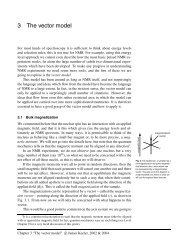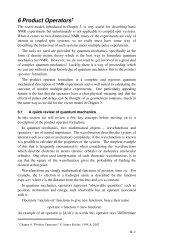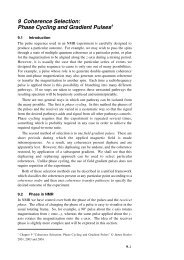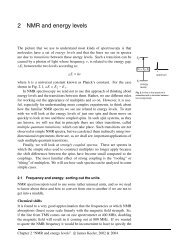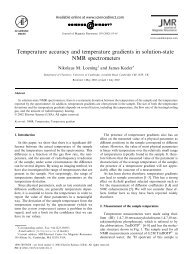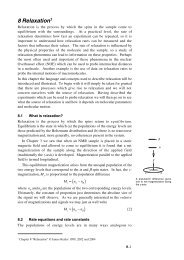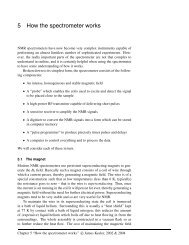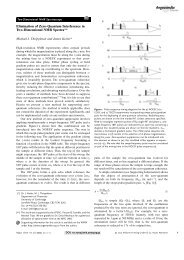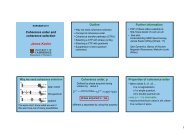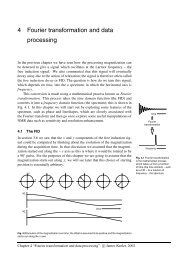Phase Cycling and Gradient Pulses - The James Keeler Group
Phase Cycling and Gradient Pulses - The James Keeler Group
Phase Cycling and Gradient Pulses - The James Keeler Group
Create successful ePaper yourself
Turn your PDF publications into a flip-book with our unique Google optimized e-Paper software.
pathway experiences a phase shift of 180° <strong>and</strong> so the receiver phase must be<br />
advanced by this much. So, the receiver phases for steps 5–8 are just 180°<br />
ahead of those for steps 1–4.<br />
In the same way for steps 9–12 the first pulse again goes through the same<br />
four steps, <strong>and</strong> the phase of the second pulse is advanced to 180°. <strong>The</strong>refore,<br />
compared to steps 1–4 the receiver phases in steps 9–12 need to be advanced by<br />
– (–2) × 180° = 360° = 0°. Likewise, the receiver phases for steps 13–16 are<br />
advanced by – (–2) × 270° = 540° = 180°.<br />
Another way of looking at this is to consider each step individually. For<br />
example, compared to step 1, in step 14 the first pulse has been advanced by<br />
90° so the phase from the first pulse is – (1) × 90° = –90°. <strong>The</strong> second pulse<br />
has been advanced by 270° so the phase from this is – (–2) × 270° = 540°. <strong>The</strong><br />
total phase shift of the required pathway is thus –90 + 540 = 450° which is an<br />
equivalent phase of 90°. This is the receiver phase shown in the final column.<br />
<strong>The</strong> key to devising these sequences is to simply work out the two four-step<br />
cycles independently <strong>and</strong> then merge them together rather than trying to work<br />
on the whole cycle. One writes down the first four steps, <strong>and</strong> then duplicates<br />
this four times as the second pulse is shifted. We would find the same steps, in<br />
a different sequence, if the phase of the second pulse is shifted in the first four<br />
steps.<br />
We can see that the total size of a phase cycle grows at an alarming rate.<br />
With four phases for each pulse the number of steps grows as 4 l where l is the<br />
number of pulses in the sequence. A three-pulse sequence such as NOESY or<br />
DQF COSY would therefore involve a 64 step cycle. Such long cycles put a<br />
lower limit on the total time of an experiment <strong>and</strong> we may end up having to run<br />
an experiment for a long time not to achieve the desired signal-to-noise ratio<br />
but simply to complete the phase cycle.<br />
Fortunately, there are several "tricks" which we can use in order to shorten<br />
the length of a phase cycle. To appreciate whether or not one of these tricks<br />
can be used in a particular sequence we need to underst<strong>and</strong> in some detail what<br />
the sequence is actually doing <strong>and</strong> what the likely problems are going to be.<br />
9.5.5 Tricks<br />
9.5.5.1 <strong>The</strong> first pulse<br />
All pulse sequences start with equilibrium magnetization, which has coherence<br />
order 0. It can easily be shown that when a pulse is applied to equilibrium<br />
magnetization the only coherence orders that can be generated are ±1. If<br />
retaining both of these orders is acceptable (which it often is), it is therefore not<br />
necessary to phase cycle the first pulse in a sequence.<br />
<strong>The</strong>re are two additional points to make here. If the spins have not relaxed<br />
completely by the start of the sequence the initial magnetization will not be at<br />
equilibrium. <strong>The</strong>n, the above simplification does not apply. Secondly, the first<br />
pulse of a sequence is often cycled in order to suppress axial peaks in two-<br />
9–26



